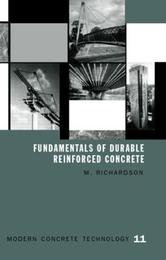
|
Fundamentals of Durable Reinforced Concrete
Hardback
Main Details
| Title |
Fundamentals of Durable Reinforced Concrete
|
| Authors and Contributors |
By (author) Mark G. Richardson
|
| Series | Modern Concrete Technology |
|---|
| Physical Properties |
| Format:Hardback | | Pages:272 | | Dimensions(mm): Height 235,Width 159 |
|
| Category/Genre | Structural engineering
Building construction and materials |
|---|
| ISBN/Barcode |
9780419237808
|
| Classifications | Dewey:624.18341 |
|---|
| Audience | | Undergraduate | | Postgraduate, Research & Scholarly | | Professional & Vocational | |
|---|
|
Publishing Details |
| Publisher |
Taylor & Francis Ltd
|
| Imprint |
Spon Press
|
| Publication Date |
23 May 2002 |
| Publication Country |
United Kingdom
|
Description
Durability failures in reinforced concrete structures are wasteful of resources and energy. The introduction to practice of European Standard EN 206-1 represents a significant shift in emphasis on the need to explicitly consider each potential durability threat when specifying and producing concrete. Fundamentals of Durable Reinforced Concrete presents the fundamental aspects of concrete durability including reinforcement corrosion, carbonation, chloride ingress, alkali-aggregate reaction, freeze/thaw damage, sulphate attack, chemical attack, cracking, abrasion and weathering. The background to the durability exposure classes in EN 206-1 is also explained. Future directions in performance-based specifications and mathematical modelling of degradation are presented. This book will be of particular interest to specifiers applying the principles of the new European Standard EN 206-1 for the first time, to postgraduate researchers in mathematical modelling of degradation mechanisms, to undergraduates of engineering, architecture and building technology, and students of advanced concrete technology who require a concise source of reference on concrete durability.
Reviews'This book will be of particular interest to specifiers applying the principles of the new European Standard EN 206-1 for the first time; to postgraduate researchers in mathematical modeling of degradation mechanisms; to undergraduates of engineering, architecture, and building technology; and to students of advanced concrete technology who require a concise source of reference on concrete durability.' - Concrete International
|